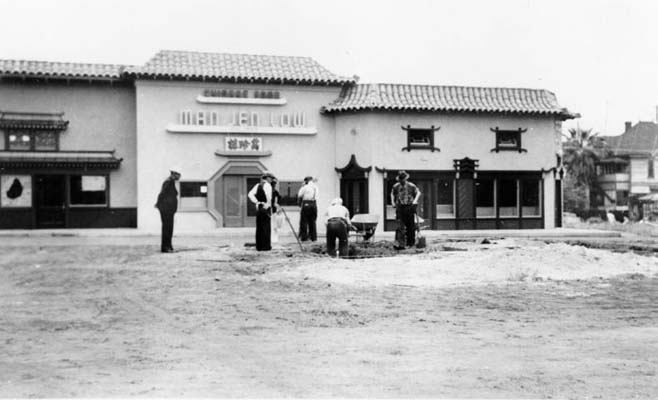Fifty years ago on the sunny Saturday of June 25, 1938, California's Governor Merriam and a host of dignitaries dedicated Los Angeles Chinatown's Central Plaza in a gala Grand Opening ceremony. One of the Nation's first malls and certainly the first modern American Chinatown, owned and planned from the ground up by Chinese, Central Plaza would provide a magnificent hub and lexus for growth into the famous colorful, vibrant Chinese American community we all know today.
Originally, New Chinatown consisted of many notable restaurants, shops, an herbal store, a grocery store, a bean cake factory, a Chinese deli and offices. In 1938, these long-time establishments were all moved from Los Angeles' Old Chlnatown, not quite a mile away. What led to this sudden mass relocation into Los Angeles' Little Italy, and the need for establishing a new Chinatown?
The first Chinese was recorded to be in Los Angeles in 1852. Continuous settlement began in 1857. By 1870, an identifiable "Chinatown" of 200 or so was situated on Calle de Los Negros - Street of the Dark Hued Ones - a short alley 50 feet wide and one block long between El Pueblo Plaza and Old Arcadia Street. These early, mostly male, Chinese were mainly laundrymen, market gardeners, agricultural and ranch workers, and road builders. Despite the heavy discrimination in the late 19th century, Chinese held a dominant economic position in the Los Angetes laundry and produce industries for several years of this period. Consequently, old Chinatown flourished, expanding eastward from the Plaza across Alameda Street and eventually attaining a population of over 3000. The Exclusion Acts inhibited any real growth for many years.
Los Angeles Chinatown Plaza
| Neighborhood: Chinatown | Category: Activities, Venues
943 N Broadway
Los Angeles, CA 90012
P: 213-680-0243Los Angeles, CA 90012
W: oldchinatownla.com
Event: 2023 LA Chinatown Firecracker PAW’er Dog Walk
When
18Feb2022
at 9:00 am to 1:00 pm
Admission Fee: $30
W: https://firecracker10k.orgEvent: 2023 L.A. Chinatown Firecracker Paw’er Dog Walk
When
18Feb2023
at 9:00 am to 1:00 pm
Admission Fee: $30
W: https://firecracker10k.orgEvent: L.A. Chinatown Firecracker Paw’er Dog Walk
When
8Mar2025
at 8:30 am to 11:00 pm
Admission Fee: $51.88
W: https://firecracker10k.orgReview It
